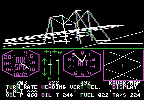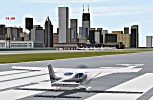The Alternate Scene
FS II for the Apple, Atari, Commodore, Ö.
When Microsoft FS 1.01 was released
as a second generation flight simulation program,
Apple owners felt left out and let Apple know about
that. And because users still had a say in 1983,
SubLOGIC hurried to port this new generation over to
the Apple II platform as FS II, version 1. Enhanced
versions for the Commodore 64 and Atari 800 (both also
equipped with the 6502 processor) followed suit in
1984.
So a whole new line of SubLOGIC
Flight Simulators developed parallel to the Microsoft
line, also developed by the same SubLOGIC crew under
the leadership of Bruce Artwick. Intrinsically the
same as version 2.10 of NS-FS, the FS II versions
profited from the (much) better graphic capabilities
of the other systems, compared to the very limited
features of the CGA graphics of the early PCís.

The first release for the Apple II
was still quite simple, but the 1984 releases for the
C64 and Atari 800 featured 8-color scenery with
buildings, roads, rivers, mountains and solid color
surfaces. It had view in 8 directions (+ downward) and
"see own airplane" form the inside (wings,
rudder). Te aircraft modelled was a Piper Archer, with
COM/NAV radios, OBI and DME. As in MF-FS 2.10,
environment could be set to wish, including season,
time of day, winds and turbulence.
The positioning system was still
very crude, with an accuracy of 256 feet. So it wasnít
even possible to use the coordinates to place a plane
on the runway, except for the slew function in zoom
mode. There were 4 scenery areas: Chicago, Seattle,
Los Angeles and New York/Boston, with in total 80
airports, with ATIS an many runways with ILS. A slew
function was provided for rapid transportation, as
between scenery areas there was absolute barrenness.

This version of FS II came with a
90 page pilotís manual and even a 92-page book on
aeronautics. With a little imagination this version
could give an "armchair pilot" the idea of
really flying! For the first time separate language
versions were published in French and German. A
drawback however was the fact that the scenery areas
were very limited and the FS-system was closed,
without any possibility for expansion by third
parties.
When newer computers arrived in
1968 like the Atari ST, Commodore Amiga and Apple
MacIntosh (all based on the same Motorola 68000
processor btw), SubLOGIC in turn responded by
developing new versions of FS II for these systems.
All in all at least 14 versions or releases of FS II
were published between 1983 and 1988, including one
for the first major laptop, the Data General 1.
Of course the new versions were
upgraded to the new features of the new systems like
16 color (but still only 320x200 screen) and the use
of a joystick. The number of scenery areas was
expanded to 5, including San Francisco, counting 120
airports in total, with correct elevations and
radio-beacons. More objects were added like buildings,
bridges, runways, mountains and roads and with greater
detail with hidden surface elimination. A map view was
added in its own overlapping and movable window. The
night panel was lit (coloured) differently.

For the first time the plane could
be seen from the outside in the Spot Plane view and
clouds and fog were actually made visible. Colors
changed corresponding to the time of day. The standard
airplane now was a Cessna Skylane 182 RG (retractable
gear), but a new plane was added: the Gates Learjet
25G turbojet with much higher speed and different
flight characteristics. All together now 47 flight
parameters were taken into account in the
calculations! The panel was expanded and included ADF
and DME and the first autopilot with wing leveller,
VOR lock, heading lock and altitude lock.
An instant replay function made it
possible to enjoy you last successful landing or to
learn form your mistakes. And a multiplayer function
made it possible to enjoy a flight with other pilots
in a network, which generated the start of flightsim
clubs all over the world, like FSFAN in The
Netherlands, later Europe. No wonder the new version
needed a 135 page manual.
Maybe the biggest changes however
were the use of a new kernel, based on the separately
by SubLOGIC developed JET simulator, that by itself
didnít survive. And the introduction on a new
ingenious coordinate system, developed by Bruce
Artwick, with an accuracy of 1/100 inch! The whole
scenery-world could be modelled in a 10.000 x 10.000
mile area with its centre (x=0, y=0) in the building
of SubLOGIC in Champaign, Illinois.
But probably even more interesting
to the flight sim fan was the release of the first
additional scenery diskettes SD1-6 by SubLOGIC in the
spring of 1988. They uncovered a lot of new territory
to the FS pilot and could also be used with MS FS
2.xx.

